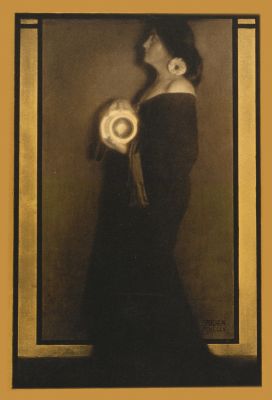
Title
The Flatiron-eveningArtist
Steichen, Edward (American, 1879-1973)Publication
Camera Work XIVDate
1906Process
Halftone (three color)Atelier
Manhattan Photogravure Company, NYImage Size
20.6 x 16 cm
The Flatiron was a very popular subject for photographers after its construction on Madison Square in 1902. Stieglitz photographed it in the winter of 1903, providing an unavoidable model for this print made by Steichen a year later. Steichen paid subtle homage to Stieglitz in his composition, even using a tree branch, sweeping from edge to edge, that relates to the tree, extending from top to bottom, in Stieglitz’s picture. But the differences in mood and light cancel out the similarities. Stieglitz isolated the building in a snowy landscape, causing it to emerge from light; Steichen chose evening light, and the building emerges from dusk. Stieglitz printed his as a small photogravure, while Steichen made an enlargement, to which he delicately applied colored pigment. Stieglitz must have held Steichen’s composition in high esteem, for he collected four examples in different hues.
Comparing this three-color halftone to Steichen’s original gum print held at the Met reveals the detailed attention Stieglitz paid to the reproduction of tone and color in Camera Work. [1]
Reproduced / Exhibited
Frizot, Michael. New History of Photography. Place of publication not identified: Pajerski, 1999. Print p. 317
Nordström, Alison D, Thomas Padon, and J L. Ackerman. Truthbeauty: Pictorialism and the Photograph As Art, 1845-1945. Vancouver, B.C: Douglas & McIntyre, 2008. Print. p 51
Rocha, Regina M, Paul Strand, and Helouise Costa. A Poética Fotográfica De Paul Strand. São Paulo, Brazil: Editora da Universidade de São Paulo, 2012. Fig. 8
Steichen, Joanna, and Steichen. Steichens Legacy, Photographs, 1895-1973: With Text by Joanna Steichen. New York: Alfred A Knopf, 2000 pl 143
References
[1] The Metropolitan Museum of Art Bulletin Spring 1978










